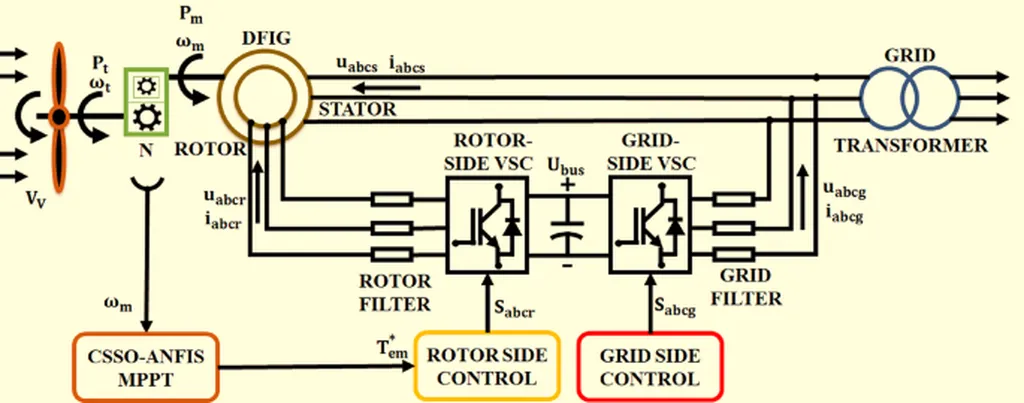In a significant stride towards enhancing wind energy systems, researchers have developed a novel control approach that promises to improve voltage stability and maximize power extraction in Brushless Doubly Fed Induction Generator (DFIG) based Wind Energy Conversion Systems (WECS). This breakthrough, published in the journal *Nature Scientific Reports*, could have substantial commercial implications for the energy sector, particularly in making wind power more efficient and reliable.
The research, led by Prashanth Rajanala from the Department of Electrical and Electronics Engineering at Koneru Lakshmaiah Education Foundation, introduces a sophisticated control framework that coordinates the Rotor Side Converter (RSC) and Grid Side Converter (GSC). This coordination allows for dynamic adjustments in rotor speed and torque, optimizing wind power extraction. “The key innovation here is the integration of a Chaotic Salp Swarm Optimization (CSSO) tuned Adaptive Neuro Fuzzy Inference System (ANFIS) for Maximum Power Point Tracking (MPPT),” explains Rajanala. This advanced MPPT system enables the wind turbines to adapt swiftly to changing wind conditions, thereby enhancing their efficiency.
One of the standout features of this control approach is its ability to support grid stability under varying conditions. By incorporating reactive power balancing and voltage regulation, the system ensures that the grid remains stable, even as wind conditions fluctuate. “This is crucial for the commercial viability of wind energy,” says Rajanala. “Grid stability is a major concern for energy providers, and our research addresses this head-on.”
The efficacy of the developed controller was validated using MATLAB/Simulink, demonstrating impressive results. The system achieved a tracking efficiency of 99.86%, with a tracking speed of 0.08 seconds and a total harmonic distortion (THD) of less than 2.85%. These metrics indicate significant improvements in voltage stability, harmonic suppression, and wind energy harvesting efficiency under both steady-state and dynamic operating conditions.
The commercial impacts of this research are substantial. By enhancing the efficiency and reliability of wind energy systems, this control approach could lower the cost of wind power, making it a more attractive option for energy providers and consumers alike. “This technology has the potential to revolutionize the wind energy sector,” says Rajanala. “It could lead to more widespread adoption of wind power, contributing to a cleaner and more sustainable energy future.”
As the world continues to seek sustainable energy solutions, innovations like this one are crucial. The research by Rajanala and his team not only advances the field of wind energy but also sets a new standard for grid stability and power extraction efficiency. With further development and implementation, this control approach could play a pivotal role in shaping the future of renewable energy.

